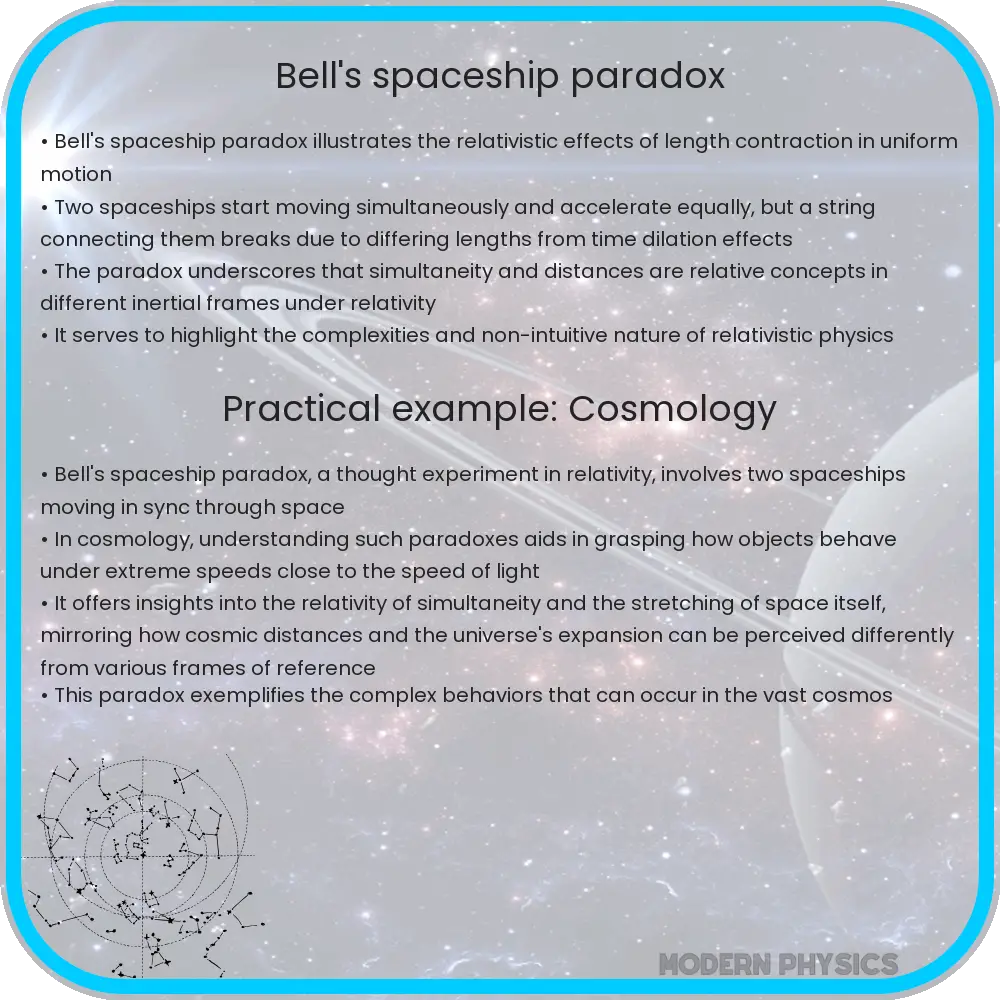Explore Bell’s Spaceship Paradox and its revelations in special relativity, examining the relativity of simultaneity and length contraction.

Bell’s Spaceship Paradox: A Journey Through Special Relativity
Bell’s Spaceship Paradox, formulated by physicist John Stewart Bell in 1959, presents an intriguing scenario that examines the implications of special relativity, a fundamental theory in physics proposed by Albert Einstein. This paradox challenges our intuitive understanding of motion, distance, and simultaneity, offering a captivating insight into the counterintuitive nature of the universe at high speeds.
Understanding the Paradox
The paradox involves two spaceships, identical in every aspect, floating in space at rest relative to each other. They are connected by a fragile thread. At a predetermined signal, both spaceships start accelerating simultaneously with the same constant acceleration, as observed from their initial rest frame. The question arises: Will the thread break due to the spaceships’ acceleration?
Insights from Special Relativity
Special relativity, primarily based on two postulates – the constancy of the speed of light in all inertial frames of reference and the equivalence of physical laws in all inertial frames, plays a crucial role in resolving this paradox. At the heart of this paradox is the concept of simultaneity and length contraction, two fundamental aspects of special relativity.
Firstly, the notion of simultaneity in special relativity is relative. What appears simultaneous in one inertial frame may not be so in another. Therefore, the simultaneous start of the spaceships’ acceleration in their original frame does not guarantee simultaneity in other frames moving relative to them.
Secondly, length contraction, a phenomenon where the length of an object moving at a significant fraction of the speed of light appears contracted in the direction of motion, comes into play. As the spaceships accelerate, they experience length contraction from the perspective of a stationary observer, while from their own perspective, they remain unchanged.
These two effects combined lead to a surprising conclusion regarding the fate of the thread connecting the spaceships. In the frame of the spaceships, the distance between them remains constant, and they accelerate simultaneously. However, from a stationary frame, the length contraction effect and the lack of simultaneity in acceleration could lead to different outcomes for the thread’s integrity.
Thus, Bell’s Spaceship Paradox is not just a thought experiment but a profound illustration of the complexities and nuances of special relativity, challenging our everyday notions of space and time.
Resolving the Paradox
To fully grasp the outcome of Bell’s Spaceship Paradox, it’s essential to delve deeper into the relativistic effects. In the stationary observer’s frame, as the spaceships accelerate, they move closer to the speed of light. This results in significant length contraction. However, the thread, not being rigid, does not experience the same degree of contraction. Consequently, from this frame of reference, the thread is stretched beyond its limits and eventually breaks.
In contrast, from the perspective of someone on one of the spaceships, the situation appears different. Here, the spaceships do not undergo length contraction relative to each other, and they maintain a constant distance apart. The acceleration is perceived as simultaneous, and thus, in this frame of reference, the thread does not break due to stretching.
Implications of the Paradox
This paradox highlights a crucial aspect of special relativity: the relativity of simultaneity. It underscores that events perceived as simultaneous in one frame may not be simultaneous in another, especially when high speeds are involved. This has profound implications in understanding the nature of time and space, influencing how we comprehend the universe’s structure at fundamental levels.
Furthermore, Bell’s Spaceship Paradox serves as a pedagogical tool in physics education, providing a tangible example to explore the concepts of special relativity. It challenges students and enthusiasts alike to rethink their preconceived notions of motion and space, encouraging a deeper exploration into the relativistic universe.
Conclusion
In conclusion, Bell’s Spaceship Paradox is more than a mere thought experiment; it’s a gateway to understanding the complex and often counterintuitive principles of special relativity. It demonstrates how our intuitive concepts of time, space, and simultaneity are fundamentally altered at velocities approaching the speed of light. Through this paradox, we gain a glimpse into the relativistic universe, where the conventional notions of motion and distance give way to a more intricate and fascinating reality governed by the speed of light. As we continue to explore the cosmos and develop technologies that push the boundaries of speed, the insights from Bell’s Spaceship Paradox remain ever relevant, guiding us in our quest to understand the universe’s deepest secrets.
Is this conversation helpful so far?
